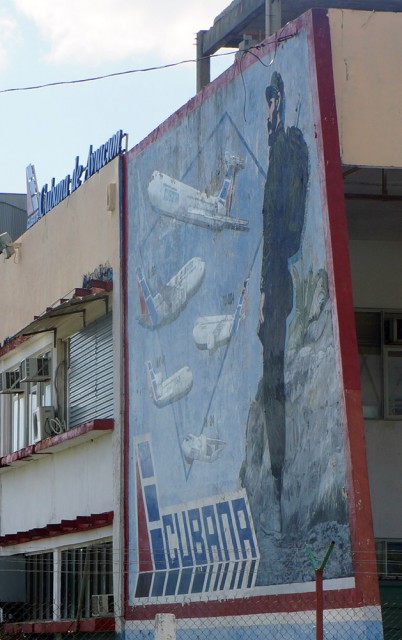
Fidel Castro, in full military garb, is painted posing with Cubana’s old Russian fleet in this mural on a wall of the airline’s maintenance base at HAV. Photo by Chris Sloan / Airchive.com.
This is an excerpt from Chris Sloan’s full story on Airchive.com:
For the first half of the 20th Century, particularly beginning during the U.S. Prohibition Era, Cuba was a playground for Americans where rum, gambling, and often-illicit activities flowed freely. Our closest Caribbean neighbor and ally to the South was also a major trading partner with the United States with many U.S. major multi-national companies having interests in sugar, farming, and tourism throughout the country. Havana, in particular was a sexy, and at times infamous place with exotic locales and attractions such as the Tropicana Night Club, Hotel Nacional, famed beaches, lively salsa music, and majestic old world architecture. The world-renowned hospitality, warmth, and exuberant personalities of the proud Cuban people were and remain an enduring feature of the nation. The mob and its iconic figures such as Meyer Lansky as well as Ernest Hemmingway’s books only enhanced Cuba’s sexiness and notoriety. It was in many ways ’œThe Las Vegas of the Caribbean’ before there was even the Las Vegas we know of today.
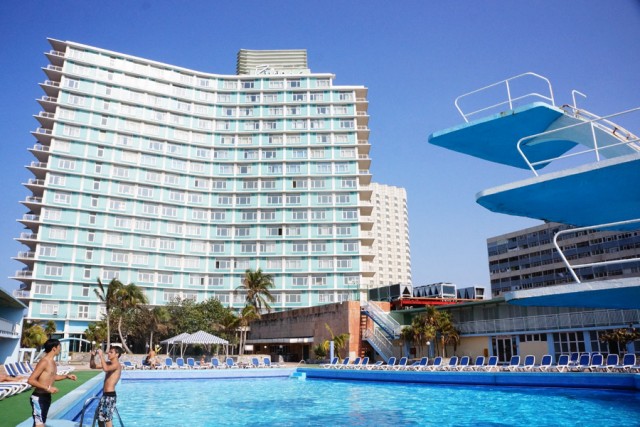
The Hotel Habana Riviera, or Havana Rivera as it is otherwise known, is located on the Malecón, looks virtually just as it did at the time of its 1957 opening. Overlooking the Gulf of Mexico, the Rivera was the first hotel in Cuba with air-conditioned rooms. After the revolution, it was taken over by the Cuban government and its casino was closed. This 350+ room hotel, remains one of the most perfectly preserved example of its kind in the world. Photo by Chris Sloan / Airchive.com.
Cuba and the United States had very close ties from the very beginning of aviation as well. Pan Am’s first flight was between Key West and Havana in 1929. Many other U.S. airlines spirited passengers, businessman, and cargo to Havana: Delta (via New Orleans), Braniff (via Houston), Pan Am (offering flights to Miami, Merida Mexico, San Salvador, and Jamaica), National (via Miami), Eastern (via Miami), and other smaller carriers such as Mackey (via Miami). Founded in 1930, Cuba’s national airline, Cubana, was once partially supported by Pan Am. CU frequently flew daily flights to Miami and New York Idyllwild first using DC-3s, DC-4s, Lockheed Constellations, Vickers jet-prop Viscount 318s and Bristol turbo-prop Britannia’s.
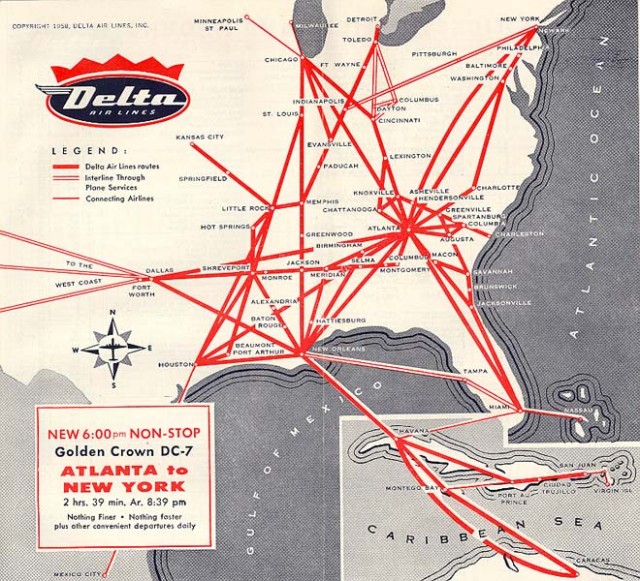
Delta served Havana and other cities in Cuba from New Orleans, its former Caribbean and Latin America gateway. Delta ended services to Cuba in 1961 under order of the U.S. government. Photo from Chris Sloan / Airchive.com.
For the citizens of Cuba, these were the best of times and the worst of times. Under an oppressive and corrupt dictatorship led by Batista who was supported by the American Government, there were a few ’œhave’s’ but many ’œhave not’s’. When Fidel Castro came to power on New Year’s Day 1959, many Cubans cheered at the prospect of change. No one really knew at the time just exactly what profound changes would come shortly to this remarkable country.
When the arguably even more brutal Castro regime began moving closer to Nikita Khrushchev and the Soviet Union during the Cold War, then nationalized all private businesses (including the foreign interests), and confiscated personal property, many Cubans and Americans fled the nation. Many felt at the time that this would be a short-term regime, not one that would be led by one of the longest lasting leader’s in modern history. Many Cubans sadly would lose everything they have and never return to their homeland again. Those that were fortunate enough to have survived the Castro regime, lost most of their personal property, businesses, homes, and especially their already limited freedom.
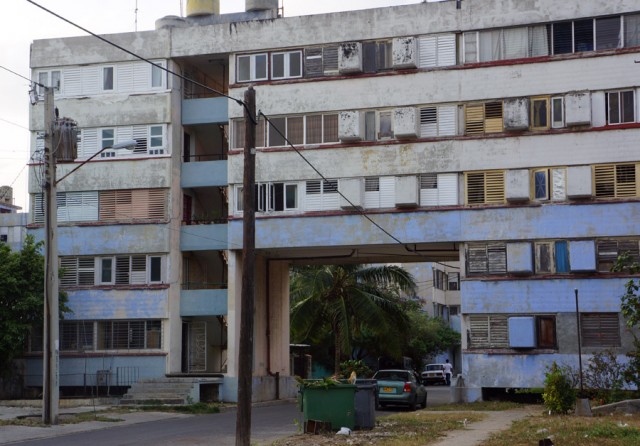
After the Revolution of 1959, American modernist and art-deco and Spanish inspired Mediterranean architecture was super-ceded by 1960s Soviet Eastern Bloc design. This ugly architecture, more at home in old East Berlin, Moscow, or Prague then the tropics is unfortunately ubiquitous throughout Havana. One can only hope that decay and new construction eventually means an end to these eyesores. Photo by Chris Sloan / Airchive.com.
The United States began limiting travel to Cuba shortly after the Revolution in 1959. Diplomatic relations were broken off in 1961, and following the Cuban Missile Crisis of October 1962 travel and trade restrictions were officially imposed under the Trading with the Enemy Act. An embargo on all business with the island Communist nation went into effect and has endured for 60 years.
Apart from humanitarian flights such as the Pedro Pan flights of the mid 1960s where children were allowed to leave Cuba for the United States; occasional relief flights, limited flights for Cubans to visit home, and a short time during the years under President Jimmy Carter when restrictions were loosened for educational, religious, and cultural exchanges were allowed, travel to the island nation has been virtually off limits. Following the often disastrous and tragic era of the Muriel Boatlift of 1980, President Ronald Reagan once again made travel to Cuba off-limits to most Americans in 1982.
For many, many years the only U.S. airlines operating to Cuba were those whose airplanes were hijacked ’“ a particularly frequent occurrence in the 1970s and early 1980s.
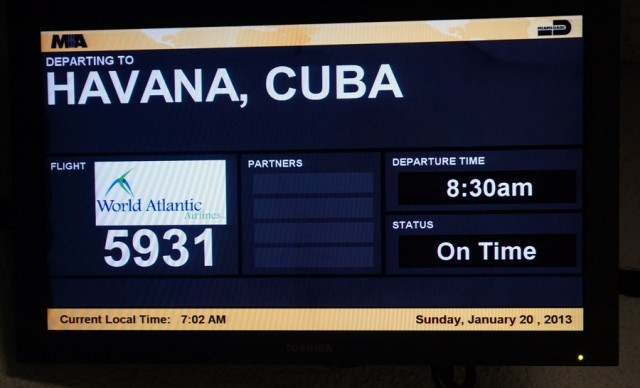
It’s not every day the Flight Information Screens display Havana Airport as a destination unless you’re at Miami International Airport. Photo by Chris Sloan / Airchive.com.
Technically it is not illegal for Americans to actually travel to Cuba, but the U.S. government prohibits its citizens from spending money in the country unless they fall into one of the groups with legal reasons to go there. Lured by the ’œforbidden fruit’ of Cuba, many Americans have illegally flown to Cuba via the Bahamas, Mexico, and Canada.
Those traveling illegally to Cuba run the risk of heavy fines and jail sentences through the Department of the Treasury. Though Cuba doesn’t stamp U.S. passports, there are many ways the United States government can detect travel to Cuba including access to airline’s reservation systems.

N802WA, a World Atlantic McDonnell Douglas MD-83, is the airplane we flew to Havana. It was built in 1990. Before flying for World Atlantic, the airplane flew for bankrupt Spanair. WAA’s Boeing MD-83 aircraft have a new interior and new configuration of 155 one class seats, providing with seat pitch ranging from 30’³ to 33’³. Photo by Chris Sloan / Airchive.com.
Cuban Americans visiting family are still the most frequent travelers between the United States and Cuba. In 2011, an estimated 400,000 Americans visited Cuba both legally and illegally, up from 250,000 in 2010. This is a surprisingly large portion of the 2.5 million annual visitors to Cuba. These are predominantly tourists from Canada and Europe who are drawn to this relatively inexpensive tropical paradise, with its wealth of culture, history, hospitality, and budding resort industry. Americans, however are barred from these resorts, and are discouraged from even visiting the beaches.
As a resident of Miami (sometime called Havana North), an aficionado of Cuban culture, a global wanderer and well, let me just say it ’œA Wandering Jew’, I had always had a fascination to visit this off-limits Island. When my synagogue Temple Beth Shalom in Miami Beach organized a humanitarian and cultural exchange trip, my wife and I leapt at the chance. The story of our 6-day trip to Cuba is one left to another post, and one difficult to put concisely into words.
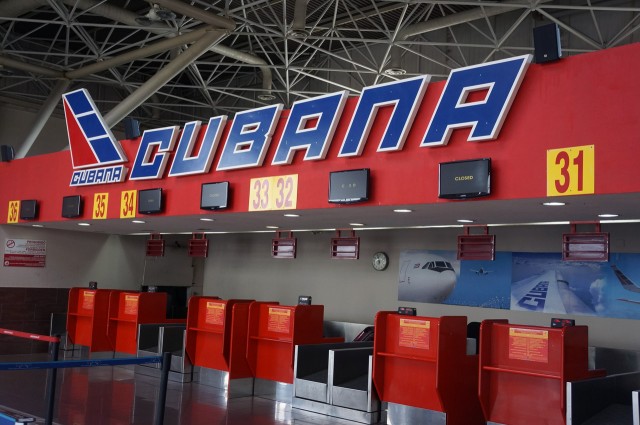
Unsurprisingly, Cubana dominates operations at Havana Jose Marti. Their ticketing takes up half of all space in Terminal 3, the newest at HAV. Photo by Chris Sloan / Airchive.com.
It is a bittersweet experience of paradoxes and contradictions. On one hand, it is fascinating and beautiful. On the other hand, it’s tragic, sad, and desperate. Two things stood out the most: Traveling to Cuba is indeed stepping back in time and not just because half the cars on the road are pre-1959 ’œDetroit Steel’. Second, the people in spite of all they have endured remain warm, and full of passion. We never once felt unsafe or unwelcome, except by 2 aggressive customs officer on the way out of the country.
Sixty minute private interrogations even if eventually communicated to me as ’œroutine’ are never fun, especially in a country that’s still a police state. But back to the positives, as an affirmed AvGeek, the experience of flying to Cuba nonstop from Miami and a visit to Jos Martà International Airport were of almost equal attraction in anticipation and in hindsight.
CONTINUE READING (MORE AWESOME AIRPLANE + CUBAN PHOTOS TOO) ON TRAVELING TO CUBA ON AIRCHIVE.COM
Other Good Cuban Stuff:
- Fascinating Cubana 50th Anniversary Booklet
- Cubana Route Maps and Timetable
- Aeroflot and Russian aircraft memorabilia
- Aeroflot timetables and route maps
 |
This story written by… Chris Sloan, Correspondent.
Chris has been an airline enthusiast, or #AvGeek, since he was 5 years old. Over the years, he has amassed an extensive collection of aviation memorabilia and photos that he shares on his site, Airchive.com. He is the President and Founder of the TV production and promotion company, 2CMedia.com and Executive Producer and Creator of ’œAirport 24/7’ Travel Channel series. |